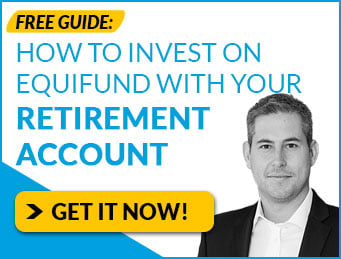If you’re new to Pre-IPO investing, you may have heard the terms Regulation Crowdfunding (Reg CF) and Regulation A+ (Reg A) thrown around…
But chances are, you probably don’t know the major differences between each type of offering (and how it could potentially impact you as an investor).
Today, we’re going to dive into these two exempt offering frameworks…
How they’ve set the stage for equity crowdfunding as we know it…
And the major differences investors need to know before investing.
But before we get into that, first…
A Brief History of Stock Market Regulations
For most of human history, investing in securities was limited to only the wealthy. It was believed that because of their wealth, they could handle the high risk – and high potential for fraud – that came with investing.
However, as the importance of the stock market grew, it became a larger influence on the overall economy.
Eventually, as people started earning higher disposable income, more people began investing in the markets.
In theory, these investors were protected by something called “Blue Sky Laws” – a term said to have originated in the early 1900s, gaining widespread use when a Kansas Supreme Court justice declared his desire to protect investors from speculative ventures that had “no more basis than so many feet of ‘blue sky.’”
But without any real regulatory oversight, it did little to protect investors from companies that issued stock (“Issuers”), promoted real estate, and other investment deals while making lofty, unsubstantiated promises of greater profits to come.
By the 1920s, the economy was “roaring” along, and people were desperate to get their hands on anything to do with the stock market.
To make matters worse, many investors began using a new tool called “margin” to use their existing stocks as collateral to borrow money from their broker and invest in more stocks.
Stock prices went up nearly 10 times as ordinary individuals bought stock, often for the first time.
With so many uninformed investors jumping into the speculative craze… brokers, market makers, and even bankers started manipulating the markets to drive prices higher before dumping their shares on the unsuspecting public.
Then, on Oct 29th, 1929, “Black Tuesday” – the largest one-day drop in stock market history – sent the country spiraling into the Great Depression.
So, as the government does, they decided to hold hearings and figure out who to blame.
In 1932, the U.S. Senate Banking Committee began a much-publicized investigation of the nation’s financial sector known as the “Pecora hearings.”
These hearings revealed how the country’s most respected financial institutions had knowingly misled investors, acted irresponsibly and participated in widespread insider trading.
Congress realized they needed to do something to restore public confidence in the U.S. markets.
On May 27, 1933, the Securities Act of 1933 was passed.
According to Investor.gov, The Securities Act of 1933 has two basic objectives:
- To require that investors receive financial and other significant information concerning securities being offered for public sale; and
- To prohibit deceit, misrepresentations, and other fraud in the sale of securities.
And it also did another important thing…
Rule 501 of Regulation D of the Securities Act of 1933 (Reg D) provides the definition for an accredited investor, which you qualify by meeting one (or both) of these criteria…
- A natural person with income exceeding $200,000 in each of the two most recent years or joint income with a spouse exceeding $300,000 for those years and a reasonable expectation of the same income level in the current year.
- A natural person who has an individual net worth, or joint net worth with the person’s spouse, that exceeds $1 million at the time of the purchase, excluding the value of the primary residence of such person.
But at the time, there wasn’t a government entity to enforce these laws.
On June 6, 1934, President Franklin D. Roosevelt signed the Securities Exchange Act of 1934, which created the Securities and Exchange Commission (SEC).
This Act gave the SEC extensive power to regulate the securities industry, including the New York Stock Exchange (and others).
The SEC demanded more disclosure and set strict reporting schedules; All companies offering securities to the public had to register and regularly file with the SEC.
The act also cleared the way for civil charges to be brought against companies and individuals found guilty of fraud and other security violations.
This would also set off a series of additional legislation over the years as a way to increase investor protection and regulatory oversight.
However, because of state Blue Sky Laws, not all securities were regulated at the federal level.
This created an opportunity for state-level regulations to further protect investors.
Then, in 1936, Regulation A was adopted by the SEC as an exemption for small issues under the authority of Section 3(b) of the Securities Act.
In 1956 the Uniform Securities Act was passed, forming the foundation for 40 out of 50 state Blue Sky Laws.
Its purpose is to deal with securities fraud at the state level and to assist the Securities and Exchange Commission (SEC) in enforcement and regulation.
They also require Issuers to reveal the terms of the offering, including disclosures of material information that may affect the security.
However, there are certain exempt offerings (also called “covered securities”) that are not required to file on a state-by-state basis; securities listed on a national stock exchange and offerings under Rule 506 of Regulation D.
However, thanks to The JOBS Act, two additional exempt offering frameworks were created…
Reg CF and Reg A+
On May 16, 2016 “Title III – CROWDFUNDING” of the JOBS Act went into effect.
Title III of the JOBS Act amended Section 4 of the Securities Act of 1933.
This created a new exempt offering framework for Internet-based securities offerings of up to $1 million over a 12-month period (and has since been updated to $5 million over a 12-month period).
The purpose of this framework was designed to help small and startup businesses conduct low-dollar capital raises on the Internet.
It also included a number of investor protection provisions, including:
- Investment limitations
Accredited investors can invest an unlimited amount into Reg CF offerings.
Non-accredited investors are limited to a percentage of their income or net worth over a rolling 12-month basis (go here to calculate your annual limits).
- Issuer disclosure and reporting requirements
All issuers must file a Form C with the SEC, as well as annual reports.
For issuers seeking to raise less than $1 million, they are required to provide reviewed financials.
To raise more than $1m, they are required to provide audited financials.
- Requirement to use regulated intermediaries
While Reg CF offerings are exempt from Blue Sky Laws, all offerings must be hosted by a FINRA registered funding portal, broker dealer, or banking institution.
Lastly, all securities purchased under Reg CF are subject to a twelve (12) month lock up.
This means you cannot sell these shares to someone else during this time frame unless they meet certain strict requirements.
However, even after the lockup period ends, there may not be a secondary market available to sell your shares.
On June 19, 2015, “Title IV – SMALL COMPANY CAPITAL FORMATION” of the JOBS Act went into effect.
Title IV amended Section 3(b) of the Securities Act 1993, creating a second tier of Regulation A:
- Tier 1 – Regulation A: This option lets Issuers raise up to $20M. But it is subject to Blue Sky Laws. This means that companies must qualify or register the offering with any state they plan to sell securities in, and every state is different.
If the offering is Tier 1, the company has no ongoing disclosure or reporting obligations to provide ongoing information to you.
However, Tier 1 is rarely used.
- Tier 2 – Regulation A+: This option lets Issuers raise up to $50M (now $75M). Except it is not subject to Blue Sky Laws.
And here’s where investors need to be careful…
A company can raise capital using Reg A+ without using an SEC or FINRA registered broker-dealer (BD) or agent in 41 of 50 states.
- The states a company would not be able to sell in are: Florida, Texas, Arizona, New York, North Dakota, Alabama, Nevada, New Jersey, and Washington.
If an Issuer is raising capital via Reg A+ and is not hosting their offering with a registered BD, buyer beware!
With that said, many many issuers elect to host their Reg-A+ via a registered BD to gain access to a wider audience within the territories where the BD is registered (up to all 50 states, and the Virgin Islands, Puerto Rico, and District of Columbia).
Additionally, because the offering is hosted with a regulated BD, if the BD fails to take reasonable measures to protect investors, they could potentially lose their license, or worse.
To be clear, this does not mean BD hosted Reg A+ offerings are any safer than any other opportunity that may be offered by a private issuer.
It only offers a representation to the investor that the BD is required to conduct additional due diligence on behalf of investors, which may promote the disclosure of additional information which may help the investor make a more informed decision.
Like all private investments, they should still be considered high risk.
And even though Reg A+ does not come with some of the restrictions Reg CF does… this doesn’t mean there is an established market where you will be able to sell your shares.
Additionally, there is an extra feature of Reg A+ that can be problematic for investors.
When a company is raising money through a Reg A+ offering, it can opt to let previous shareholders sell up to 30% of the offering.
For example, if the Issuer is selling $10 million worth of equity in a Reg A+ offering, up to $3 million of the funds raised could go to existing shareholders to “cash them out.”
On one hand, this provision can be a good thing; Issuers can provide early shareholders a way to exit their positions.
On the other hand, it also provides a perfectly legal mechanism for running a “pump and dump.”
While we won’t risk a lawsuit by naming names…
We’ve personally seen several Reg-A+ offerings where the valuations are completely divorced from reality (i.e. they are massively inflated)…
And the founders – or financiers – stand to become instant millionaires by dumping some (or all) of their shares onto the unsuspecting retail investor.
But here’s the good news…
All Issuers must file a Form 1-A with the SEC as part of their offering, and are required to disclose, in no uncertain terms, that existing shareholders are selling their shares.
They are also required to provide two-years of audited financials as part of their initial filing.
They also have ongoing reporting requirements: A company that completes a Tier 2 offering must file an annual report with the SEC, including annual audited financial statements and a semiannual report with unaudited financial statements.
Both of these reports must contain updated information on the company and progress on its business plans.
Also, a company must file periodic reports upon the happening of certain material events.
Unfortunately, most investors either don’t read the Form 1-A or are otherwise unaware this is a potential problem.
Last but not least, the final major difference between Reg CF and Reg A+ are the investor limits.
Like Reg CF, accredited investors can invest an unlimited amount in Reg A+ offerings on an annual basis.
However, non-accredited investors are limited to up to 10% of the greater of their income or net worth on a per deal basis… not a rolling 12-month basis!
Final Thoughts
Before investing in any Reg CF or Reg A+ offering, it’s important to do your own due diligence.
It doesn’t matter how slick the marketing materials are, or if it was recommended to you by a third party who supposedly vets opportunities, the “source of truth” is in the filings.
If you’re new to Pre-IPO investing, I recently recorded a ~2 hour training called “Introduction to Pre-IPO Investing” which you can find here:
If you’d like a deeper dive into things like due diligence, you can find our entire Private Market Investing Workshop training program by going to this page here.
If you have any other questions about Pre-IPO investing – or how Reg CF and Reg A+ work – hit reply to any email we send you and it’ll come straight to my inbox.
While we can’t provide any individualized advice, we are here to help understand Pre-IPO investing and how it fits into a broader portfolio strategy.
Sincerely,
Jake Hoffberg – Publisher
Equifund












